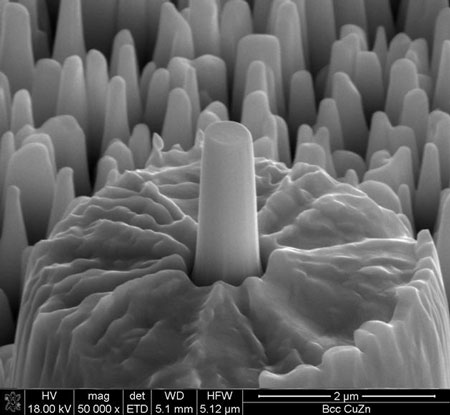| Jan 28, 2011 |
Memory training for metal structures
|
|
(Nanowerk News) Structured surfaces have special properties. It would be desirable to make these properties switchable. This, for example, would allow for friction and adhesion to be specifically switched on and off on metallic surfaces. How to train structured surfaces for this effect has been under investigation by the junior research group "Metallic Microstructures" at INM — Leibniz Institute for New Materials since January 2011.
|
|
Some materials, so-called shape memory alloys, change their shape when temperature is increased. The metals have a "memory" for the shape to which they change at higher temperature. "But this deformation is irreversible – a switch is not obtained with this one-way effect alone," explains Andreas Schneider, head of the new group. "For this purpose we need to train the material. This can be achieved with a suitable combination of heat treatment and deformation." Then the material memorizes the shape at a higher and lower temperature. This two-way memory effect allows for making the surface structures switchable via temperature. Thus, for example, friction and adhesion on surfaces can be specifically switched on and off.
|
 |
| copper-zinc micropillar
|
|
The group's second focus of research is based on microstructures that influence the strength of a metal surface. "We recognize that a metal is the stronger the smaller the structures on the surface are made. Many thin pillars bear a temple roof better than a few thick pillars", explains the junior researcher. The research group studies which influences lead to this effect.
|
|
The scientists produce the microstructures among other things with a scanning ion microscope, removing minutest amounts of metal in layers from the surface. At the end, micropillars with a fixed diameter and a fixed height protrude from the metal. With a stamp, which presses from above onto the pillars, the scientists test the forces which the pillars withstand, before they cave in.
|
|
Metals with a specific crystallographic structure are used. The metals niobium, wolfram, tantalum and molybdenum have already been studied and have a body-centred cubic structure. Materials which are reinforced by oxide particles will also be investigated by the research group. It is known that these oxide particles make metals stronger. The group studies whether this also proves to be effective in the nano-micro scale.
|
|
Background
|
|
Andreas Schneider studied materials science at the University of Stuttgart and at the Max Planck Institute for Metals Research. In 2010, he received a doctor's degree summa cum laude under the supervision of Eduard Arzt in Stuttgart. Schneider gained excellent research results, which are reflected in numerous publications. His excellent work prompted the management's decision to further promote the junior researcher as the head of an own junior research group.
|
|
With this new junior research group, INM not only expands its spectrum of research towards metals but also promotes the mechanical characterisation on the nano and micro scale. With this, INM bridges the gap from mechanical measurements on the atomic level over the nano scale towards macroscopic sizes. Besides metals the institute also uses this measurement method for biological materials, such as nacre.
|
|
The INM — Leibniz Institute for New Materials, situated in Saarbrücken (Germany), engages in fundamental and applied materials research – from molecules to pilot production. In interdisciplinary cooperation, the work of INM includes the fields of chemical nanotechnology, interface materials and materials in biology. Its focal areas are based in chemical synthesis, physical analysis of surfaces, coatings and interfacial materials.
|

